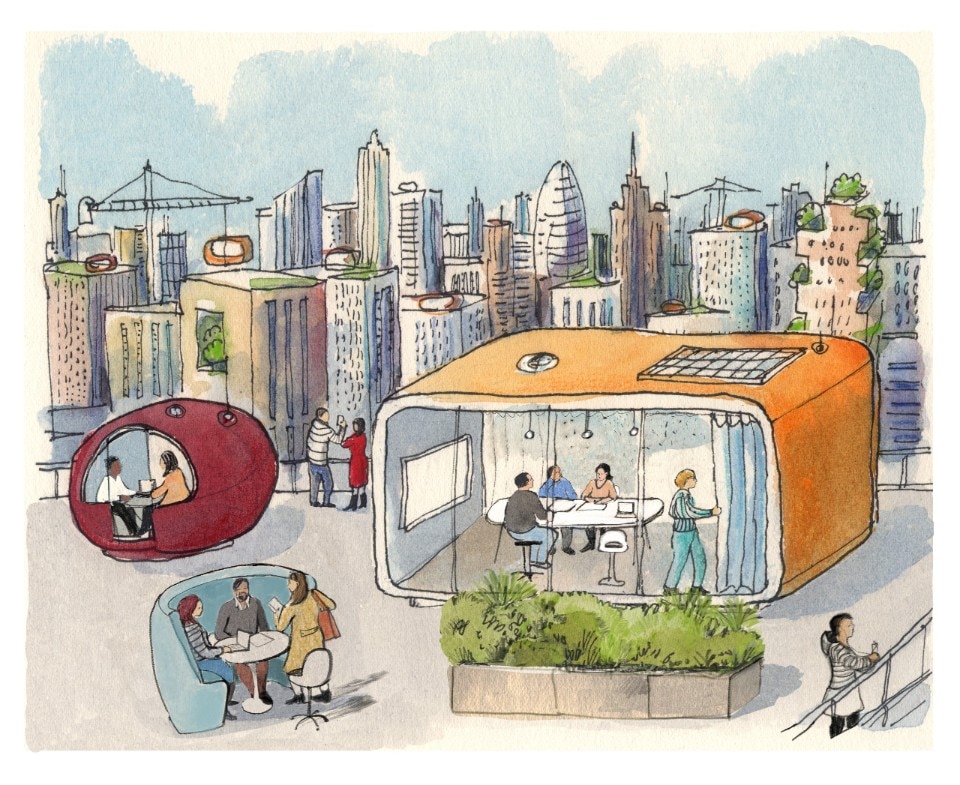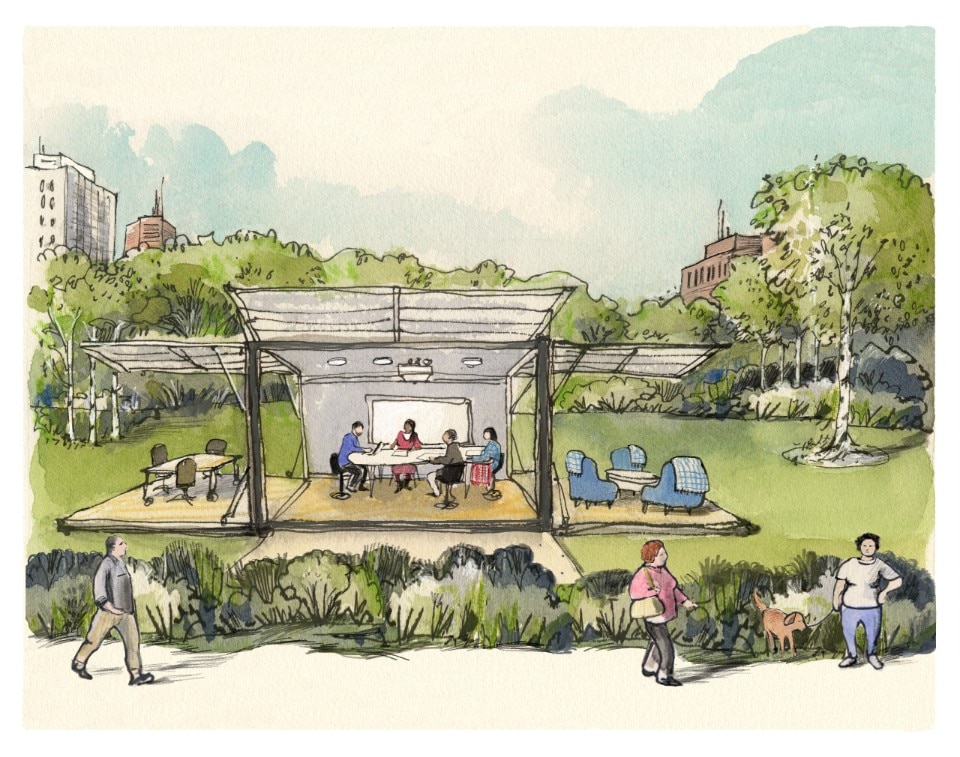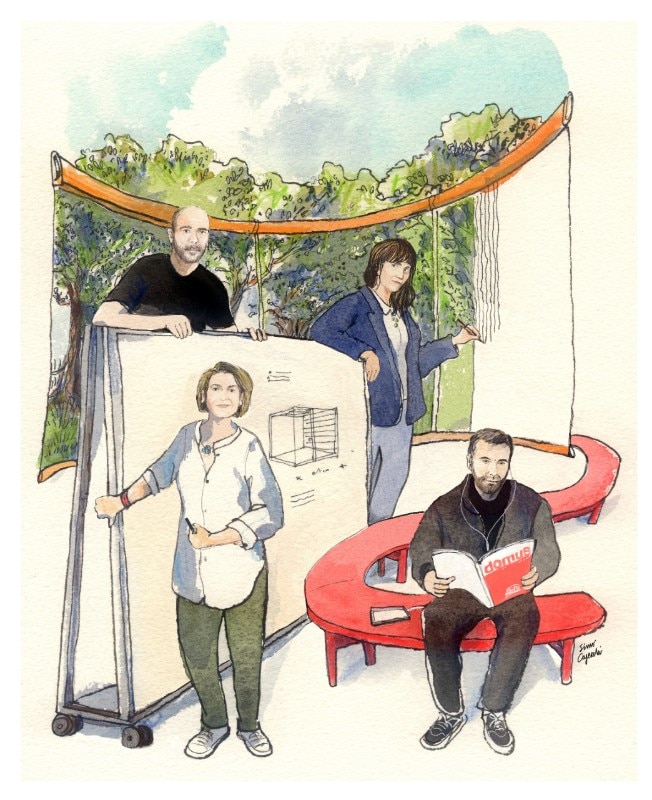This article was originally published on Domus 1059, july and august 2021.
- Nicola Russi e Angelica Sylos Labini:
- architects, co-founders of Laboratorio Permanente
- Jonathan Olivares:
- industrial designer
- Marianna Fantoni:
- Fantoni technical director
Laboratorio Permanente: During the pandemic, work spaces, and especially coworkings, were the most affected. Work has changed in its form and tools. And its relation to the city has changed, but we still have to understand exactly where it’s going. Currently, for instance, we’re working with a large American company to see how we can change its headquarters, which we’d already designed, to be more responsive to the new working methods. To do this, we decided to interview the employees. On average, people prefer to work at the office three days a week. This means space need is about 20 percent less. Consequently the desks could be reduced by 60 percent and so they’d no longer be individual, but used in rotation. Personal lockers were needed so they could leave their materials at the office. The informal work space – for meetings, training and workshops – was expanded to take up 50 percent of the total space. Shared spaces have also been increased by up to 160 percent: cafés, conference centres or breakout areas. In general, the workspace is becoming an ecosystem that vastly expands the number and type of functions to be designed.
Marianna Fantoni: This is a tangible change that we’re also seeing in the office furniture sector. There’s been an exponential increase in the demand for microarchitectures for informal working. Classic desks are no longer sufficient to meet current needs. Companies are making over their spaces to offer employees tools enabling them to choose different ways of working, just as they need them. The demand is for spaces that can be transformed rapidly, for microarchitectures, individual or collective, flexible units that are independent of the buildings containing them. Then it should be possible to reconfigure these spaces daily and efficiently, so that the same setting can adapt to multiple situations. Such infrastructures serve above all to stimulate synergies within companies, and this can only happen by creating informal spaces for human and professional relationships.
Jonathan Olivares: I can relate to what you’re saying. In fact, I chose to close my physical studio and explore alternatives to the traditional office. The 2015 New York Times article by Adam Davidson about the “Hollywood model” in office organization was influential: any film is made by a purpose-built team, and at the end of the project the team dissolves, and the members go on to form new teams or new films. So I felt that model could suit my design practice, because the type of things I design – from an interior to an exhibition to a product – change and require different skill sets from collaborators. Building project teams works well for my purposes and allows me to avoid managerial tasks required by a full-time staff. I work from home but a key ingredient to my way of practice is movement, changing environments and travel: meetings with collaborators generate a lot of energy, and then ideas often come to me on the road or in places where I would least expect. So the pandemic really hampered my way of practice.

LP: We agree. Offices will increasingly become places that stimulate exchanges. The trend towards sharing collective spaces between companies is also growing, producing networks of relationships. Commuting will change, in the sense that we won’t necessarily work from home, but we’ll be able to do it within our own neighbourhood, so restoring a wealth of functions to the city. Some companies, for instance, are already gearing up with co-working spaces of the kind common in cities. But we think that, while individuals will need an office less, companies still seem to need the cultural symbol behind the architectural form of their headquarters.
MF: Then there is an increasing concern for sustainability and issues related to the circular economy. The importance of recycling and rationalising processes are the ways we have chosen, as a company, to respond to this new awareness of the environment. At the same time, a different culture of work is emerging on the market, certainly more inclusive of the needs of employees. In fact, we see that the layouts are the result of a more conscious and multipurpose kind of design. For example, we’ve been able to design solutions to ensure privacy for mothers who are breastfeeding at the office.

JO: What allows this transformationwe’re talking about is technology, and it’smore and more pervasive. We’ve beenusing these tools for the past 15 years,but these methods were predicted 50,or even 60 years ago. All software andplatforms for remote group workingthat we’ve used over the past monthswere already available, from videoconferencing, to cloud storage, to cloud-based work platforms.
LP: With the pandemic we also realisedthat we need closer contact withnature, so the paradigm of comfort haschanged. It looks less like a standard ofenvironmental quality and increasingly likethe shade of a tree. As architects, we seeoutdoor workspaces as a growing trend.We’re experimenting a lot in this respect.We’ve just completed a project thatoffers touchdown workstations, meetingrooms and chat rooms.
With the pandemic we also realisedthat we need closer contact withnature, so the paradigm of comfort haschanged. It looks less like a standard ofenvironmental quality and increasingly likethe shade of a tree.
JO: Marianna talked about sustainability, and from this point of view outdoor workspaces allow us to save lots of energy. From lighting to managing indoor microclimates, costs are drastically cut when work moves outdoors. Another positive aspect is greater psychological wellbeing. The challenges are mainly the conflict between natural lighting and screen visibility and noise which lowers our ability to stay focused. For these reasons it is important that the outdoor work typology does not attempt to replicate indoor work typologies, but find its own language. I think the time has come to reintroduce elements of vertical division in work environments because we’ve become used to a different level of privacy during the pandemic, but also because the vast majority of employees before the pandemic preferred privacy. We are rarely given the chance to start over, as a culture with our office interiors, and the pandemic has provided that chance for many companies, if not to culture at large.


